| 1 | A Californian rock field lover |
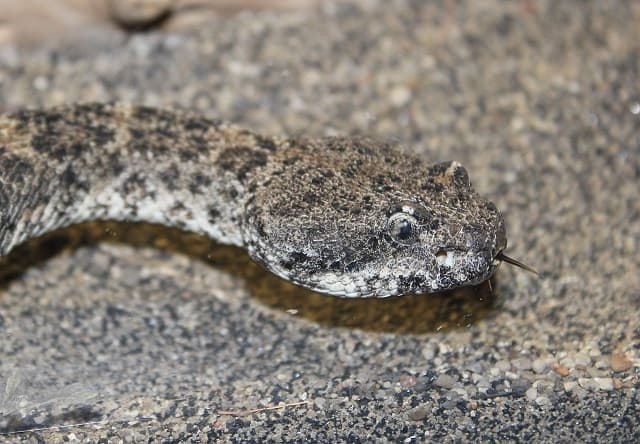
The southwestern speckled rattlesnake (Crotalus pyrrhus) is an intermediate-sized, intermediately toxic species of the southwestern USA. They’re found in 4 US states, plus parts of northern Mexico. They inhabit most of southern California, the western portions of Arizona, extreme southwest Utah, and southeast Nevada, including the outskirts of Las Vegas.
Rather than lush pine-oak forests, Crotalus pyrrhus is a creature of hot semi-desert areas, especially rocky deserts, where they lurk in crevices to hide from the beating desert sun. Rocky desert slopes are a favourite, as well as dry canyons, erosion gullies and dry foothills covered with cacti and creosote bushes. Their habitats are extremely similar to the rock rattlesnake, but that species fizzles out in eastern Arizona, and southwestern speckled rattlers take their place in the vacant ecosystem further west.
This species’ easternmost point lies in Phoenix, Arizona. In their semi-deserts, they overlap with several cousins like Mojave rattlesnakes and western diamondbacks, while their territory only has a slight overlap with tiger rattlesnakes near Phoenix (which mainly live further east). Southwestern speckled rattlesnakes average at 90cm, with males significantly longer than females. The longest on record measured 132cm, with an earlier record of 129.5cm reported in 1935.
| 2 | From grey to pink to beige |
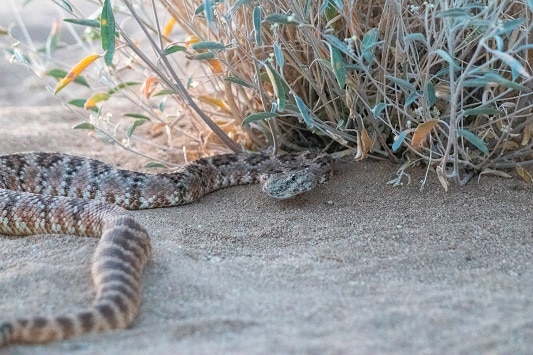
Crotalus pyrrhus can be a tricky species to recognise, as there are no instant ID signs, as with a black-tailed rattlesnake. They vary according to different rock substrates, typically being a granite grey, but also yellow-pink, blueish green, pinkish-grey and beige. There’s even a blackish colony at the Pisgah lava flows of San Bernadino County, California. The patterns are more consistent, with the classic speckled form, but some have body-encircling bands. This species rarely has “clean” patterns; they tend to look fuzzy like the static of a malfunctioning TV.
Southwestern speckled rattlesnakes have a black tongue and a relatively short tail, at just 5-9% of total body length. This species has a confusing family tree, as it was originally one species: the speckled rattlesnake (Crotalus mitchellii). However, it turns out that those in the USA were a fully separate species. As of 2023, Crotalus mitchellii lives only in the lower 50% of Baja California, Mexico. All US versions are its close relative, the southwestern speckled rattlesnake (Crotalus pyrrhus), which also occupies the northern half of Baja California, and extreme northwestern Sonora state (Mexico).
This separation only happened in 2015, so many older studies which discuss Crotalus mitchellii in Nevada or Arizona are really referring to Crotalus pyrrhus. The two species have many similarities, but have a genetic divergence of 5.0-6.4%.
| 3 | No confirmed deaths |
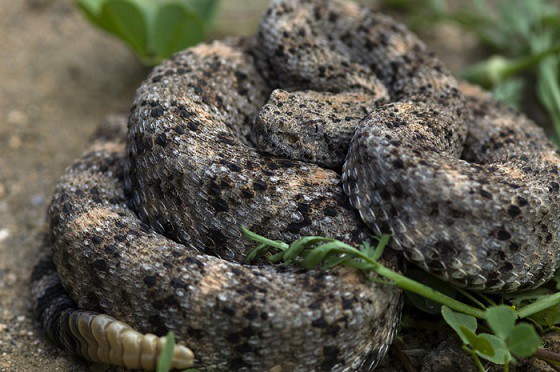
Crotalus pyrrhus is considered moderately dangerous within the rattlesnake family, albeit with a few lingering question marks. Like the black-tailed rattlesnake, no deaths from envenomation have ever been confirmed, not in the 21st century, nor during the wild west. A study on the Baja California version, the speckled rattlesnake (Crotalus mitchelli) found it to be the most potent of 4 local rattlesnakes. Its LD50 score was 0.35mg, defeating the Baja Cali rattlesnake (1.56mg), Santa Catalina rattler (2.98mg), and San Lucan rattlesnake (9.21mg).
However, the signs suggest that the US version is significantly weaker. In separate studies, the LD50 scores for Crotalus mitchellii ranged from 0.13-2.05mg when tested intraperitoneally in mice, versus 1.35-4mg for Crotalus pyrrhus. Another estimate for the LD50 rating in mice was 2.7mg for the US species. This is far weaker than a tiger rattlesnake (0.06mg).
A reason for bites being so rare is that Crotalus pyrrhus prefers to to fly under the radar. A snake removal company in Phoenix reported that Crotalus pyrrhus made up 7.4% of their removals, compared to the ubiquitous western diamondback rattlesnake in first place at 85.1%. This is despite the hiking trails near Phoenix, Arizona being one of the species’ hotspots. Crotalus pyrrhus is particularly common at Cave Creek just north of Phoenix.
| 4 | Specialises in swelling |
Southwestern speckled rattlesnakes are usually categorised as a Class I species, causing local chaos but no neurotoxicity (tiger rattlesnakes are a class II). Swelling is easily the most consistent symptom of this species. An older case involved a bite to the left thumb, with swelling spreading to the pectoral and axilla (armpit) regions. In a case involving a bite to the heel, significant swelling spread to the calf and leg by 4 hours post-bite.
The most detailed cases yet came in a 2-part Arizona study from 2018. Case one occurred in the Tinajas Altas Mountains of Yuma County, Arizona. On May 9th 2009, a 21 year old male was bitten on his thumb by a 45cm long Crotalus pyrrhus. As he reached his vehicle 30 minutes later, swelling had already reached his wrist. After reaching Yuma Regional Medical Center, 2.5 hours post bite, his entire left hand was swollen.
The swelling reached halfway up his left lower arm, but there were no systemic symptoms (vomiting, haemorrhaging, etc). The functioning of his left hand was poor. He soon received several vials of the standard CroFab antivenom. Over 4 days, there was no evidence of coagulopathy or hypofibrinogenemia, a deficiency in the clotting material fibrinogen. There was no free bleeding; the only symptom related to blood clotting was a slight thrombocytopenia, a deficiency in bloodstream platelets. The man was released after 4 days, and recovered fully, with no lasting consequences.
| 5 | Amputation may be necessary |
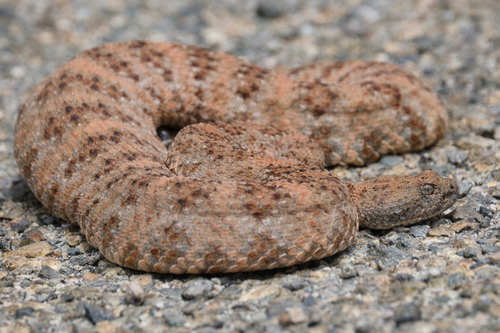
Case 2 was far severer than the first, ultimately causing an amputation. A 29 year old man was attempting to photograph a southwestern speckled rattlesnake, on a trail situated in Arizona’s Phoenix Mountain Preserve, Maricopa County. The attempt ended with a bite to his right third finger, which later manifested as a single fang puncture mark. 45 minutes later, the man reached a medical centre, where the wound was covered with dried blood, but no advanced unclottable bleeding.
By now, his entire right hand was swollen. The patient received antivenom, and was transferred to an intensive care unit. Like case 1, there was no coagulopathy, no deficiency in fibrinogen or bloodstream platelets. His blood clotting remained normal, but the swelling continued to advance, and more worryingly, a necrotic area of tissue and haemorrhagic bullae spread from the bite site, disfiguring his finger.
This worsened until 36 hours post bite, when a hand surgeon stepped in, and concluded that the rotting skin tissue was of indeterminable viability. The man was discharged on day 3, having received 36 vials of antivenom. On day 10, the man returned for reassessment. The tissue of his right third finger was finally deemed non-viable, and the tip was amputated.
While case 2 was far more brutal than 1, the two were similar in their extreme swelling, with much of the surrounding limb inflating, and the absence of systemic effects like vomiting, nausea, and spontaneous bleeding.
| 6 | Hibernates in rock formations |
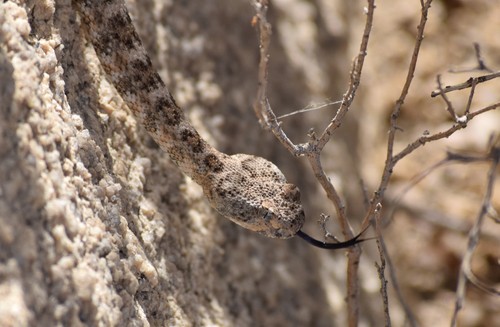
One study followed speckled rattlesnakes in the Eldorado Mountains of Nevada, eastern Mojave desert. It found that speckled rattlesnakes hibernated in dens in rocky outcrops, sometimes individually, but more commonly in small groups of 2-10 rattlesnakes. Very occasionally, a rattlesnake would emerge in mid-winter, possibly to drink water, but they would never travel far.
The usual hibernation period was mid-October to late March. After emerging, the speckled rattlesnakes travelled a short distance (just a few metres) to a rocky shelter, and remained there for 3-4 weeks, in a state of relative inactivity. Then they would rev up, and from approximately April 20th to June 6th, they would relentlessly pursue rattlesnakes of the opposite sex.
The study tracked speckled rattlesnakes from 2006 to 2009, and found that speckled rattlesnakes were a relatively lazy species. With a sample size of 29, males moved an average of 18.0 metres daily, while the 11 females slithered an average of 11.2 metres. A sidewinder rattlesnake can move over 200 metres per day. During the mating season, they were much more active, with males moving an average of 30.2 metres daily.
Males of this species are larger than females. The population ratio is also unbalanced in favour of males, and males commonly duel for the rights to a female.
| 7 | May contain secret neurotoxins |
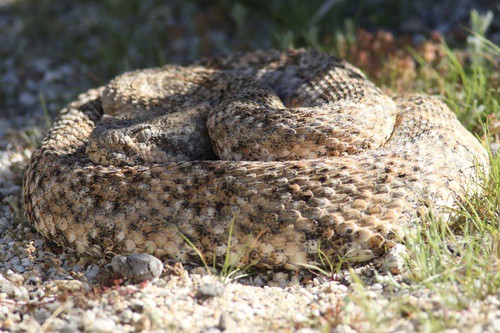
It seems that this rattlesnake holds a secret, a secret of geographical variation. Mojavetoxin is the most feared toxin of the rattlesnake family. It’s the neurotoxin responsible for slurred speech, trouble walking and respiratory failure, and is the reason why Mojave and tiger rattlesnakes outstrip the others for deadliness. With Crotalus pyrrhus being a close relative of the tiger rattlesnake, there was always a chance it would pop up. Samples listed as being from Baja de los Angeles (Baja California) and Arizona have tested positive for mojavetoxins, but other samples from San Felipe (Baja California), Arizona and southwest Utah have tested negative.
While normally mild, there may be certain unlucky corners of California where southwestern speckled rattlers are doubly or quadropoly deadly. Another worry is that speckled rattlesnakes aren’t included in the venom pool of CroFab, the US’ most commonly used rattlesnake antivenom.
Freshly extracted Crotalus pyrrhus venom has a PH calculated at 5.52, The venom also contains several non-offensive peptides designed to increase stability while it sits in the venom gland. A study on Crotalus mitchelli found that the venom didn’t weaken over time, as a batch analysed in 1960 had retained its potency for 27 years.
| 8 | Easy to feed in captivity |
Any species has variation between individuals, but rumour is that speckled rattlesnakes are aggressive, and won’t shy away from hissing and creating a deafening racket. While some individuals lie quietly and rely on camouflage, others are nervous, and will coil and strike while rattling non-stop. Crotalus pyrrhus is capable of forming a coil in mid-air, and there’s even rumours of spraying people in the eyes. Spitting venom is common in cobras, but extremely rare in vipers, let alone the specific rattlesnake family.
While speckled rattlesnakes shouldn’t be underestimated in captivity, they’re at least easy to feed. One snake keeper reported 6 young in one batch, which ranged from 24.0-25.5cm. The mother had been scooped up near Cape Creek, Arizona, and immediately began feeding on adult mice. 5 were alive, and 1 born dead. They were born on October 13th, and the keeper successfully fed one for the first time on November 2nd, dropping a pinkie mouse into their cage and waiting for it to disappear.
Two of the newborns were particularly reluctant to feed. It took till January 3rd and 4th for them to swallow their first pinkie, although their bodily condition remained healthy, with no hunger folds. The author mentioned how previous rattlesnake juveniles had gone 4 months without eating after being born. This is a long-lived snake, as an adult male captured in the wild lived an extra 22 years and 16 days. This was kept in Los Angeles Zoo.
| 9 | Diet of a speckled rattlesnake |
The rock rattlesnake eats 55.4% reptiles, whereas red diamond rattlesnakes eat 91.6% mammals. Southwestern speckled rattlesnakes are part of the mammal-eating crew, according to a 2021 study. This studied wild-caught Crotalus pyrrhus, from 6 separate regions in Nevada, Arizona and California. The scientists discovered 104 prey items from 72 individual Crotalus pyrrhus. The verdict was 80.8% mammals, with 26.9% coming from the Chaetodipus pocket mice genus. They had a particularly love for terrestrial squirrels, at 39.4% of prey identified.
Males and females had similar diets, but juveniles preferred lizards, which shifted towards mammals into adulthood. There was also variation by region; Crotalus pyrrhus from the Tinajas Altas Mountains, Arizona preyed disproportionately on birds.
Confirmed prey include…
- Harris’s antelope squirrel (Ammospermophilus harrisii).
- Bryant’s woodrat (Neotoma bryanti).
- Common chuckwalla (Sauromalus ater).
- Western tanager (Piranga ludoviciana).
One of the largest ever food items witnessed was a nearly fully grown desert cottontail rabbit (Sylvilagus audubonii). Their hunting style is standard for rattlesnakes: a mixture of ambush and active foraging depending on circumstances depending on terrain, and whether there’s any exceedingly obvious mammal trails to position themselves next to.
| 10 | Gathers rainfall on scales |
In 2007, the southwestern speckled rattlesnake became another species shown to collect rainwater on its own scales. It was a study from the Mojave desert, from the Eldorado mountains of Clark County, Nevada, which followed 29 radiotracked Crotalus pyrrhus, 20 male and 9 female.
In July, the author was in a rocky area and detected 6 of his rattlesnakes in crevices, hidden from sight. It had rained earlier that day, and at 15:04, the showers resumed. The author sat by the entrance of one crevice, and at 15:10, a rattlesnake emerged. It first began licking droplets off of rocks, repeatedly flecking its tongue. At 15:16, it then flattened its body, elongating its ribs to increase the surface area. Almost immediately, the rattlesnake began running its head up and down the length of its body, evidently licking up collected droplets. This trick had been proven for western diamondbacks just a couple of years earlier.
The author then noticed that 5 other rattlesnakes had been summoned to the surface by the rainfall, despite being hidden moments ago. On November 30th 2007, a Crotalus pyrrhus emerged from its burrow during a sudden Mojave desert rainstorm, despite having been hibernating since early October. Though drinking wasn’t observed, the author believed this to be the only explanation.
